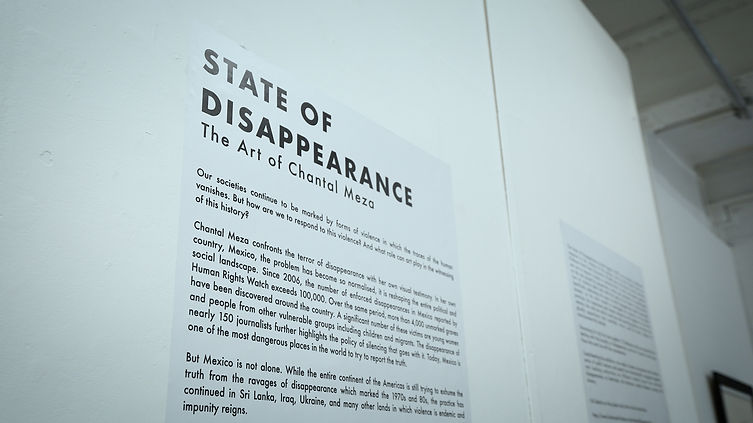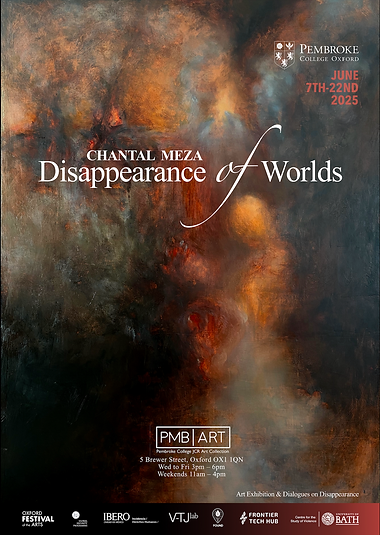
About the Project
The disappearance project started in 2017. It wasn't a problem we sought to pursue out of some intellectual/academic curiosity or as an object for research and study. Chantal Meza’s home country of Mexico had become the global epicentre for the crisis. The problem arrived to her, and it couldn’t be ignored. Her response was to start producing a series of artworks, which weren’t intended for public display, but to try and make sense of what was by definition unintelligible.
This became the basis for a series of in-depth conversations held with survivors, searching family members, policy makers, artists and critically engaged scholars as we sought to understand more about the issue.
Disappearance, as we came to appreciate, poses a fundamental challenge for all known categories as it takes us beyond all limits for intelligibility. This raised a number of pressing questions as we started mapping out this project, not least: - How are we to understand this phenomenon? Why does it prove so effective? Why has insufficient attention been given to its lasting effects? What are its spatial and temporal dimensions? How do we understand its psychological implications? What does it mean when thinking about perpetrators, victims and witnesses? Moreover, what forms does disappearance take? Is the problem more than just bodies? And most importantly, how should we respond?
Between 2017-2022, Meza produced a collection of 75 works that specifically addressed these concerns. A conversation was also published between Brad Evans and Meza for the Los Angeles Review of Books that addressed our early concerns. During this time, Evans was inspired by Meza’s aesthetic insights and began writing on disappearance, notably how it challenged the necessity for witnessing in the face of absence, along with how it forced a fundamental rethinking on the politics of annihilation and how we deal with the terror of the void. His first sustained analysis was published in the book Ecce Humanitas: Beholding the Pain of Humanity (Columbia University Press: 2021), which featured some of the art collection and opened new enquiry.
This eventually gave rise to the State of Disappearance Project, which subsequently led to an edited book of that name published by McGill-Queens University Press (2023). It featured the contributions of 12 globally renowned academics reflecting on Meza’s artworks. A key focus was to rethink what disappearance actually meant as a historical and contemporary problem. A webinar series was later developed in partnership with the journal the Philosopher, which featured conversations with a number of the volumes contributors.

During this time, a number of joint public lectures were delivered at prominent universities and public settings, including Harvard University, NorthWestern University Paris Programme, Goethe University Frankfurt, University of Oregon, University of Cork, the École Normale Supérieure, Paris, along with BRLSI and Mission Theatre in Bath.
Having organised a public performance event that brought together live painting, classical music and contemporary dance on the site of a former military base in Heidelberg, Germany, titled Dance for the Disappeared, a number of small workshops were also organised on the theme. These occurred while more extensive preparations were being made for the first public exhibition of the full collection, which took place at Centrespace gallery in the City of Bristol between 28th Oct – 8th November 2023.


Partnered with the Arts Council, UK, and with funding from the Economic, Social and Research Council, the State of Disappearance exhibition brought art into conversation with academics and advocacy groups to raise awareness and instigate public debate. The success of this exhibition was measured in a number of ways. As it drew notable media attention, it led to an invitation to showcase some of the collection and lead a dedicated stream at Humanitarian Xchange in London (2024), which was the largest ever gathering of humanitarian actors and organisations in the capital. The exhibition also became the catalyst for series of conversations, one of which led to an international conference held at Queens University in Belfast in June 2024, along with an invitation to edit a special edition of the United Kingdom’s longest running philosophy journal, The Philosopher, which had a core section of essays on Disappearance and Oblivion and featured Meza’s artwork throughout.


Numerous academic essays and op-eds were also written and published in a variety of outlets, including the Times Higher Education Supplement, the Conversation, Review of Education, Pedagogy and Cultural Studies, UnHerd, Trebuchet Arts Magazine and Wissenschaft und Frieden (Science & Peace).
Marking the 10th anniversary of the 43 disappeared students in Ayotzinapa, Mexico, on September 26th 2024, the full State of Disappearance collection was selected by the University of Bath to launch its new Art on Campus initiative. The event was officially opened by the Vice Chancellor of the University, Professor Phil Taylor, and was attended by many dignitaries, including the mayor of the City, the leader of the council and Lord Lieutenant of Somerset. While some of the collection has been curated in the open-planned space of the lofty and prestigious Chancellors building to invite contemplative reflection, in a bold and original move the collection continues in a dedicated teaching room, bringing the art directly into spaces for learning and conversation.
In May 2024, Meza gifted the entire State of Disappearance collection to the university for its permanent display and for use in advancing education on the subject.
The dedicated art space featuring the collection has been used for a number of prominent occasions, including an event that welcomed leading experts and family members who have been affected by the violence of disappearance during “The Troubles” in Northern Ireland, which included, Michael McConville, Shauna Moreland, Dympna Kerr and Sandra Peake.



Throughout this period, Meza and Evans also began focusing on the ecological dimensions to disappearance, including the weaponisation of ecologies and the disappearance of life-world systems. A new collection of artworks was produced and new research streams developed. The first showing of these works was at the Eden Bleeds exhibition at St Marys Cathedral in Bristol between March 8th-April 22nd 2025, which was another solo exhibition featuring Meza’s work. This was the very first contemporary art exhibition held in the iconic venues 800-year old history. The exhibition also featured on BBC 1 Easter Sunday morning live broadcast. Attendance figures for the exhibition exceeded 10,000 visitors and viewing figures for the broadcast were over ½ million.
Building on from this, the project returned to the issue of enforced disappearances, while looking at the intersection between life, ecology and technology with the Disappearance of Worlds exhibition. Featuring new works, it ran between June 7th to 21st, 2025, at Pembroke Art Gallery, Pembroke College, University of Oxford. The exhibition was officially opened with a conversation between Chantal Meza and renowned journalist and art writer, Will Gompertz. A series of prominent talks, panel discussions, and events were linked to this exhibition, including testimonies from Índira Navarro – Leader, Searching Mothers’ Collective ‘Guerreros Buscadores de Jalisco’ and Lizet & Carmen Cardona of 'Corazones Robados' Searching Mothers’ Collective.
Chantal Meza's featured artwork from the exhibition, Dreams of Disappearance (2025) was jointly acquired by Pembroke College and the JCR Art Fund to be part of its collection and is set for permanent display at the University of Oxford.






Evans & Meza are currently completing the Disappearance of Worlds book, which is set for publication in 2026. In addition to this, a series of academic volumes are currently being produced, which address directly the aesthetics of disappearance for journals Thesis Eleven and Review of Education, Pedagogy & Cultural Studies.
Looking ahead, a major exhibition has recently been confirmed and will be held at the Capilla del Arte Museum in Puebla, Mexico, which is set for Feb-June, 2027.